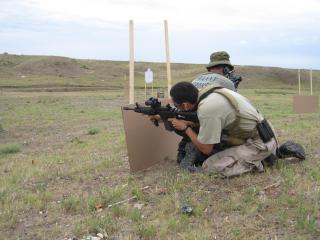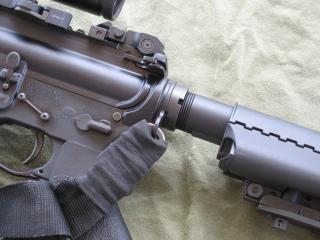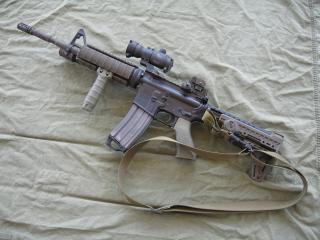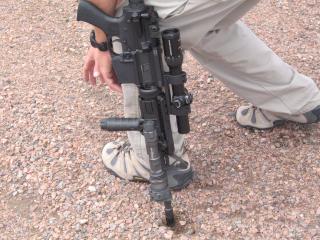Published in Guns & Ammo's Tactical Guns & Gear, December 2006

 The single-point sling allows easy cross-shoulder transitions, shown here during
a live-fire movement drill.
It's been said that a handgun is merely for fighting one's way to a rifle, and
just as no serious pistolero goes forth without a holster, neither should a
long-gun be used without a sling of some sort. In the dim recesses of time,
there were basically two types of rifle slings. The first is a simple loop
sling use to carry the rifle, and the second is the M1907 Military Rifle Sling,
designed primarily as a marksmanship aide and used secondarily for carrying.
The loop sling easily carries the long-gun, and it can be used as an improvised
shooting sling. The M1907 distinguishes itself as a shooting aide, but is also
used to carry the rifle. A rifle slung with either of these slings in the
conventional fashion over the back is not easy to employ quickly, since the
shooter must untangle himself from the rifle and re-orient the rifle before
shooting.

 The Troy CQBOPS sling snaps into a receiver sling loop from Yankee Hill Machine
(YHM).
Modern tactical sling provides two basic functions. The first is to allow the
rifle to be carried in a ready position, for quick employment. The second
function is to secure the rifle during transitions to a secondary weapon, while
doing a "hands on" task like handcuffing, or while negotiating obstacles.
Tactical slings for carbines, shotguns, and submachine guns are generally one of
three types: single-point, two-point, and three-point. A "single-point" sling
is a single loop which goes around the shooter's body, over one and under the
other shoulder. It connects to the weapon near the stock to receiver
junction. The single-point sling provides minimal support for carrying the

 Specter Gear MOUT single-point sling on the Magpul M93 stock's
single-point sling mount.
weapon, but provides maximum range of motion when the weapon is in use. A
single-point sling allows shooting from any position including from
weak-shoulder without the shooter extricating himself from the sling. When
dropped during a secondary weapon transition, the long-gun simply hangs from the
single connection point. This provides minimal control of the weapon during
movement and isn't the best way to hump a rifle over a long distance. The
single-point sling merely keeps track of the weapon when it's not in use.

 Single-point slings, lacking control of the front-end of the weapon, let the
muzzle hit the deck when crouching or kneeling.
When the rifle is dropped into the "down" position on the single-point sling, it
just dangles. During a pistol transition, the muzzle can hit the shooter's
knee-caps, and if the rifle is hanging while the shooter is walking, for example
carrying something else, the carbine is likely to bang between his legs as he
strides forward.
Unlike the other two types of slings, the single-point does not do a good job
retaining control of the rifle. While a two- or three-point sling will control
the muzzle, a single-point sling does not, and the muzzle will to hit the ground
when kneeling, crouching, or doing other low to the ground tasks.
|